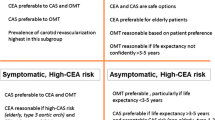Opinion statement
Recent randomized clinical trial data support the safety and efficacy of carotid artery stenting and carotid endarterectomy for treatment of symptomatic and asymptomatic carotid occlusive disease. Endarterectomy is more effective in preventing stroke, but this may be countered by a higher risk of perioperative myocardial infarction. Age is an important determinant in selecting patients for either carotid endarterectomy or stenting. Patients older than 70 years achieve better outcomes with endarterectomy, and younger patients achieve better outcomes with stenting. Comparative clinical and anatomic durability of endarterectomy and stenting will require additional follow-up from recently completed trials. The efficacy of carotid revascularization compared with modern medical therapy in asymptomatic patients remains an important and unanswered clinical question.

Similar content being viewed by others
References and Recommended Reading
Papers of particular interest, published recently, have been highlighted as: • Of importance •• Of major importance
Petty GW, Brown Jr RD, Whisnant JP, et al.: Ischemic stroke subtypes: a population-based study of incidence and risk factors. Stroke 1999, 30:2513–2516.
Gurm HS, Yadav JS, Fayad P, et al.: Long-term results of carotid stenting versus endarterectomy in high-risk patients. N Engl J Med 2008, 358:1572–1579.
Mas JL, Chatellier G, Beyssen B, et al.: Endarterectomy versus stenting in patients with symptomatic severe carotid stenosis. N Engl J Med 2006, 355:1660–1671.
SPACE Collaborative Group, Ringleb PA, Allenberg J, et al.: 30 day results from the SPACE trial of stent-protected angioplasty versus carotid endarterectomy in symptomatic patients: a randomized non-inferiority trial. Lancet 2006, 368:1239–1247.
Brott TG, Hobson 2nd RW, Howard G, et al.: Stenting versus endarterectomy for treatment of carotid-artery stenosis. N Engl J Med 2010, 363:11–23.
International Carotid Stenting Study Investigators, Ederle J, Dobson J, et al.: Carotid artery stenting compared with endarterectomy in patients with symptomatic carotid stenosis (International Carotid Stenting Study): an interim analysis of a randomized controlled trial. Lancet 2010, 375:985–997.
Ederle J, Bonati LH, Dobson J, et al.: Endovascular treatment with angioplasty or stenting versus endarterectomy in patients with carotid artery stenosis in the Carotid and Vertebral Artery Transluminal Angioplasty Study (CAVATAS): long-term follow-up of a randomized trial. Lancet Neurol 2009, 8:898–907.
Hopkins LN, Roubin GS, Chakhtoura EY, et al.: The carotid revascularization trial: credentialing of interventionalist and final results of lead-in phase. J Stroke Cerebrovasc Dis 2010, 19:153–162.
Chiam PT, Roubin GS, Iyer SS, et al.: Carotid artery stenting in elderly patients: importance of case selection. Catheter Cardiovasc Interv 2008, 72:318–324.
Chaturvedi S, Dumont AS: The learning curve for neuroendovascular procedures: how important is it? [editorial]. Neurology 2009, 72:1974–1975.
Bonati LH, Jongen LM, Haller S, et al.: New ischaemic brain lesions on MRI after stenting or endarterectomy for symptomatic carotid stenosis: a substudy of the International Carotid Stenting Study (ICSS). Lancet Neurol 2010, 9(4):353–362.
Endovascular versus surgical treatment in patients with carotid stenosis in the Carotid and Vertebral Artery Transluminal Angioplasty Study (CAVATAS): a randomized trial. Lancet 2001, 357:1729–1737.
Bonati LH, Ederle J, McCabe DJ, et al.: Long-term risk of carotid restenosis in patients randomly assigned to endovascular treatment or endarterectomy in the Carotid and Vertebral Artery Transluminal Angioplasty Study (CAVATAS): long-term follow-up of a randomized trial. Lancet Neurol 2009, 8:908–917.
US Department of Health and Human Services: Centers for Medicare and Medicaid Services. NCD for Percutaneous Transluminal Angioplasty (PTA) (20.7) [Version 9], 2010. Available at http://www.cms.gov/mcd/viewncd.asp?ncd_id=20.7&ncd_version=9&basket=ncd%3A20%2E7%3A9%3APercutaneous+Transluminal+Angioplasty+%28PTA%29. Accessed June 14, 2010.
Disclosure
No potential conflicts of interest relevant to this article were reported.
Author information
Authors and Affiliations
Corresponding author
Rights and permissions
About this article
Cite this article
Barrett, K.M., Brott, T.G. Management of Stenosis of the Extracranial Internal Carotid Artery: Endarterectomy Versus Angioplasty and Stenting. Curr Treat Options Neurol 12, 475–482 (2010). https://doi.org/10.1007/s11940-010-0092-7
Published:
Issue Date:
DOI: https://doi.org/10.1007/s11940-010-0092-7




